Related Research Articles
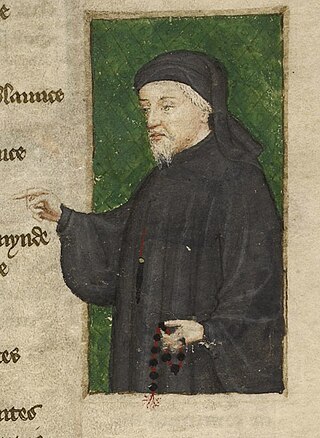
Geoffrey Chaucer was an English poet, author, and civil servant best known for The Canterbury Tales. He has been called the "father of English literature", or, alternatively, the "father of English poetry". He was the first writer to be buried in what has since come to be called Poets' Corner, in Westminster Abbey. Chaucer also gained fame as a philosopher and astronomer, composing the scientific A Treatise on the Astrolabe for his 10-year-old son Lewis. He maintained a career in the civil service as a bureaucrat, courtier, diplomat, and member of parliament.
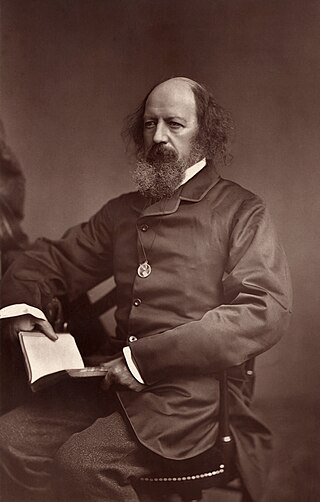
Alfred Tennyson, 1st Baron Tennyson,, was an English poet. He was the Poet Laureate during much of Queen Victoria's reign. In 1829, Tennyson was awarded the Chancellor's Gold Medal at Cambridge for one of his first pieces, "Timbuktu". He published his first solo collection of poems, Poems, Chiefly Lyrical, in 1830. "Claribel" and "Mariana", which remain some of Tennyson's most celebrated poems, were included in this volume. Although described by some critics as overly sentimental, his verse soon proved popular and brought Tennyson to the attention of well-known writers of the day, including Samuel Taylor Coleridge. Tennyson's early poetry, with its medievalism and powerful visual imagery, was a major influence on the Pre-Raphaelite Brotherhood.

Alcestis or Alceste, was a princess in Greek mythology, known for her love of her husband. Her life story was told by pseudo-Apollodorus in his Bibliotheca, and a version of her death and return from the dead was also popularized in Euripides's tragedy Alcestis.

The Romaunt of the Rose is a partial translation into Middle English of the French allegorical poem, Le Roman de la Rose. Originally believed to be the work of Chaucer, the Romaunt inspired controversy among 19th-century scholars when parts of the text were found to differ in style from Chaucer's other works. Also the text was found to contain three distinct fragments of translation. Together, the fragments—A, B, and C—provide a translation of approximately one-third of Le Roman.

The Parlement of Foules, also called the Parlement of Briddes or the Assemble of Foules, is a poem by Geoffrey Chaucer made up of approximately 700 lines. The poem, which is in the form of a dream vision in rhyme royal stanza, contains one of the earliest references to the idea that St. Valentine's Day is a special day for lovers.
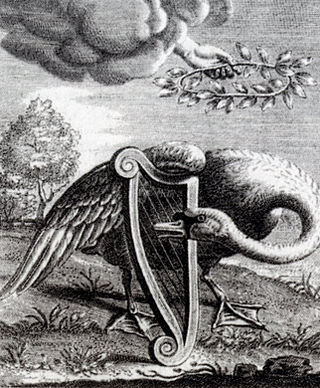
The swan song is a metaphorical phrase for a final gesture, effort, or performance given just before death or retirement. The phrase refers to an ancient belief that swans sing a beautiful song just before their death while they have been silent for most of their lifetime. The belief, whose basis has been long debated, had become proverbial in ancient Greece by the 3rd century BC and was reiterated many times in later Western poetry and art. Swans learn a variety of sounds throughout their lifetime. Their sounds are more distinguishable during courting rituals and not correlated with death.
Narrative poetry is a form of poetry that tells a story, often using the voices of both a narrator and characters; the entire story is usually written in metered verse. Narrative poems do not need to rhyme. The poems that make up this genre may be short or long, and the story it relates to may be complex. It is normally dramatic, with various characters. Narrative poems include all epic poetry, and the various types of "lay", most ballads, and some idylls, as well as many poems not falling into a distinct type.
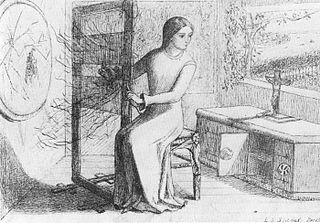
"The Lady of Shalott" is a lyrical ballad by the 19th-century English poet Alfred Tennyson and one of his best-known works. Inspired by the 13th-century Italian short prose text Donna di Scalotta, the poem tells the tragic story of Elaine of Astolat, a young noblewoman stranded in a tower up the river from Camelot. Tennyson wrote two versions of the poem, one published in 1832, of 20 stanzas, the other in 1842, of 19 stanzas, and returned to the story in "Lancelot and Elaine". The vivid medieval romanticism and enigmatic symbolism of "The Lady of Shalott" inspired many painters, especially the Pre-Raphaelites and their followers, as well as other authors and artists.

The Book of the Duchess, also known as The Deth of Blaunche, is the earliest of Chaucer's major poems, preceded only by his short poem, "An ABC", and possibly by his translation of The Romaunt of the Rose. Based on the themes and title of the poem, most sources put the date of composition after 12 September 1368 and before 1372, with many recent studies privileging a date as early as the end of 1368.

The poem In Memoriam A.H.H. (1850) by Alfred, Lord Tennyson, is an elegy for his Cambridge friend Arthur Henry Hallam, who died of cerebral haemorrhage at the age of twenty-two years, in Vienna in 1833. As a sustained exercise in tetrametric lyrical verse, Tennyson's poetical reflections extend beyond the meaning of the death of Hallam, thus, In Memoriam also explores the random cruelty of Nature seen from the conflicting perspectives of materialist science and declining Christian faith in the Victorian era (1837–1901), the poem thus is an elegy, a requiem, and a dirge for a friend, a time, and a place.

In Greek mythology, Pygmalion was a legendary figure of Cyprus. He is most familiar from Ovid's narrative poem Metamorphoses, in which Pygmalion was a sculptor who fell in love with a statue he had carved.
The Legend of Good Women is a poem in the form of a dream vision by Geoffrey Chaucer during the fourteenth century.

The House of Fame is a Middle English poem by Geoffrey Chaucer, probably written between 1374 and 1385, making it one of his earlier works. It was most likely written after The Book of the Duchess, but its chronological relation to Chaucer's other early poems is uncertain.

In English, the word laureate has come to signify eminence or association with literary awards or military glory. It is also used for recipients of the Nobel Prize, the Gandhi Peace Award, the Student Peace Prize, and for former music directors of orchestras who retain some level of involvement.

Dream of Fair to Middling Women is Samuel Beckett’s first novel. Written in English "in a matter of weeks" in 1932 when Beckett was only 26 and living in Paris, the clearly autobiographical novel was rejected by publishers and shelved by the author. The novel was eventually published in 1992, three years after the author's death.

"The Two Voices" is a poem written by future Poet Laureate of the United Kingdom Alfred, Lord Tennyson between 1833 and 1834. It was included in his 1842 collection of Poems. Tennyson wrote the poem, titled "Thoughts of a Suicide" in manuscript, after the death of his friend Arthur Henry Hallam in 1833. The poem was autobiographical.
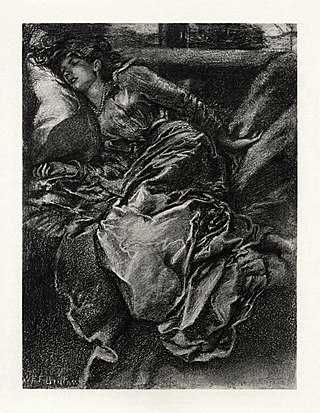
"The Day-Dream" is a poem written by Alfred Tennyson that was published in 1842. It was an expanded version of his 1830 poem "The Sleeping Beauty". It was further altered in 1848 for a dramatic performance for a private gathering with Tennyson starring as the Prince. "The Day-Dream" discusses the nature of sleeping and of dreaming, especially in relation to individuals that would want to escape from reality. The poem also compares the act of poetry with dreaming and asserts that the two are the same.

"Sir Galahad" is a poem written by Alfred Tennyson, 1st Baron Tennyson, and published in his 1842 collection of poetry. It is one of his many poems that deal with the legend of King Arthur, and describes Galahad experiencing a vision of the Holy Grail. The subject of the poem was later included in "The Holy Grail" section of Tennyson's Idylls of the King, but the latter version depicts Galahad as a pious individual who is grimly determined to fulfill his destiny. Sir Galahad, in contrast, depicts Galahad as proud, and has almost cheerful undertones.
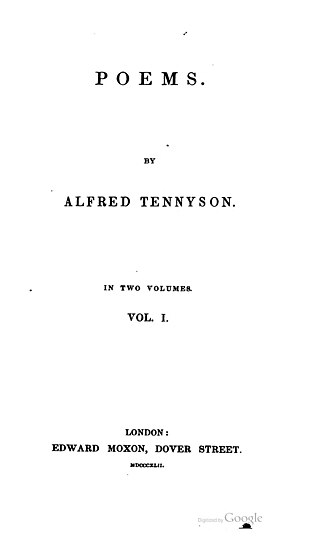
Poems, by Alfred Tennyson, was a two-volume 1842 collection in which new poems and reworked older ones were printed in separate volumes. It includes some of Tennyson's finest and best-loved poems, such as Mariana, The Lady of Shalott, The Palace of Art, The Lotos Eaters, Ulysses, Locksley Hall, The Two Voices, Sir Galahad, and Break, Break, Break. It helped to establish his reputation as one of the greatest poets of his time.
